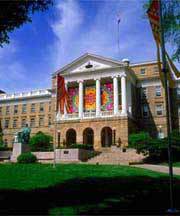Introduction
UW was first established in 1848, the same year as the state of Wisconsin. In 1849, a class of 17 students met at the Madison Female Academy. By the next year, the university had purchased 50 acres of land in downtown Madison. Women were first admitted to the university in 1863, and the Graduate School was established in 1904. In 1971, the government of Wisconsin merged the University of Wisconsin system with the Wisconsin State Universities system, putting UW Madison at the head of an addition roster of nine universities and four underclassmen branches.
The culture of UW Madison has been shaped by the “Wisconsin Idea,” which seeks to infuse the benefits of university education, in one form or another, into every single home across Wisconsin. UW is particularly friendly to university/community partnerships and cross-departmental collaboration.
One of the best known aspects of the campus is the University of Wisconsin-Madison Arboretum, which has been working to restore prairie and other native landscapes since 1934. The first-ever artist-in-residence program began at UW in 1936. In true Wisconsin style, there is an on-campus dairy facility at UW. Today, the main campus spans 933 acres. UW maintains branch campuses in Milwaukee, Green Bay, and Parkside. There are also ten underclassmen centers throughout the state.

